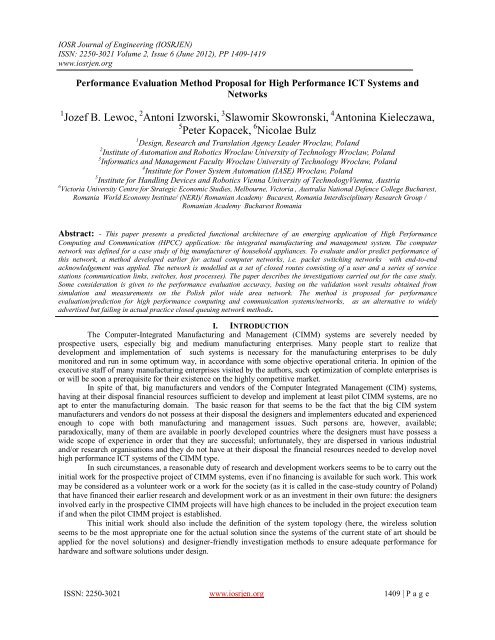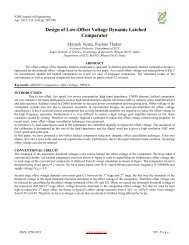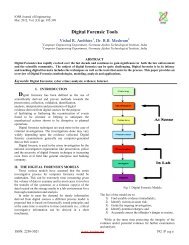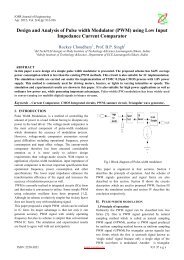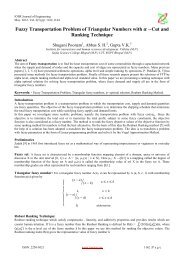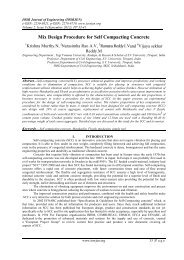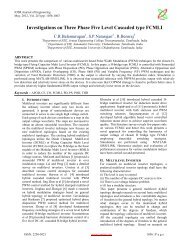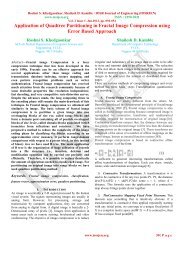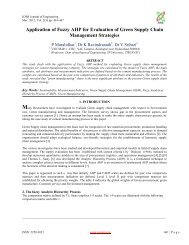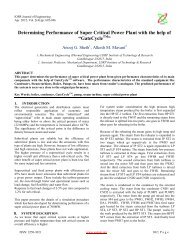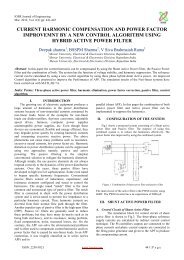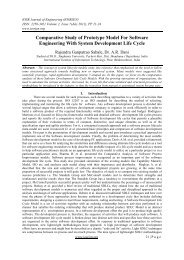Paper Title (use style: paper title) - IOSRJEN
Paper Title (use style: paper title) - IOSRJEN
Paper Title (use style: paper title) - IOSRJEN
Create successful ePaper yourself
Turn your PDF publications into a flip-book with our unique Google optimized e-Paper software.
IOSR Journal of Engineering (<strong>IOSRJEN</strong>)<br />
ISSN: 2250-3021 Volume 2, Issue 6 (June 2012), PP 1409-1419<br />
www.iosrjen.org<br />
Performance Evaluation Method Proposal for High Performance ICT Systems and<br />
Networks<br />
1 Jozef B. Lewoc, 2 Antoni Izworski, 3 Slawomir Skowronski, 4 Antonina Kieleczawa,<br />
5 Peter Kopacek, 6 Nicolae Bulz<br />
1 Design, Research and Translation Agency Leader Wroclaw, Poland<br />
2 Institute of Automation and Robotics Wroclaw University of Technology Wroclaw, Poland<br />
3 Informatics and Management Faculty Wroclaw University of Technology Wroclaw, Poland<br />
4 Institute for Power System Automation (IASE) Wroclaw, Poland<br />
5 Institute for Handling Devices and Robotics Vienna University of TechnologyVienna, Austria<br />
6 Victoria University Centre for Strategic Economic Studies, Melbourne, Victoria , Australia National Defence College Bucharest,<br />
Romania World Economy Institute/ (NERI)/ Romanian Academy Bucarest, Romania Interdisciplinary Research Group /<br />
Romanian Academy Bucharest Romania<br />
Abstract: - This <strong>paper</strong> presents a predicted functional architecture of an emerging application of High Performance<br />
Computing and Communication (HPCC) application: the integrated manufacturing and management system. The computer<br />
network was defined for a case study of big manufacturer of ho<strong>use</strong>hold appliances. To evaluate and/or predict performance of<br />
this network, a method developed earlier for actual computer networks, i.e. packet switching networks with end-to-end<br />
acknowledgement was applied. The network is modelled as a set of closed routes consisting of a <strong>use</strong>r and a series of service<br />
stations (communication links, switches, host processes). The <strong>paper</strong> describes the investigations carried out for the case study.<br />
Some consideration is given to the performance evaluation accuracy, basing on the validation work results obtained from<br />
simulation and measurements on the Polish pilot wide area network. The method is proposed for performance<br />
evaluation/prediction for high performance computing and communication systems/networks, as an alternative to widely<br />
advertised but failing in actual practice closed queuing network methods.<br />
I. INTRODUCTION<br />
The Computer-Integrated Manufacturing and Management (CIMM) systems are severely needed by<br />
prospective <strong>use</strong>rs, especially big and medium manufacturing enterprises. Many people start to realize that<br />
development and implementation of such systems is necessary for the manufacturing enterprises to be duly<br />
monitored and run in some optimum way, in accordance with some objective operational criteria. In opinion of the<br />
executive staff of many manufacturing enterprises visited by the authors, such optimization of complete enterprises is<br />
or will be soon a prerequisite for their existence on the highly competitive market.<br />
In spite of that, big manufacturers and vendors of the Computer Integrated Management (CIM) systems,<br />
having at their disposal financial resources sufficient to develop and implement at least pilot CIMM systems, are no<br />
apt to enter the manufacturing domain. The basic reason for that seems to be the fact that the big CIM system<br />
manufacturers and vendors do not possess at their disposal the designers and implementers educated and experienced<br />
enough to cope with both manufacturing and management issues. Such persons are, however, available;<br />
paradoxically, many of them are available in poorly developed countries where the designers must have possess a<br />
wide scope of experience in order that they are successful; unfortunately, they are dispersed in various industrial<br />
and/or research organisations and they do not have at their disposal the financial resources needed to develop novel<br />
high performance ICT systems of the CIMM type.<br />
In such circumstances, a reasonable duty of research and development workers seems to be to carry out the<br />
initial work for the prospective project of CIMM systems, even if no financing is available for such work. This work<br />
may be considered as a volunteer work or a work for the society (as it is called in the case-study country of Poland)<br />
that have financed their earlier research and development work or as an investment in their own future: the designers<br />
involved early in the prospective CIMM projects will have high chances to be included in the project execution team<br />
if and when the pilot CIMM project is established.<br />
This initial work should also include the definition of the system topology (here, the wireless solution<br />
seems to be the most appropriate one for the actual solution since the systems of the current state of art should be<br />
applied for the novel solutions) and designer-friendly investigation methods to ensure adequate performance for<br />
hardware and software solutions under design.<br />
ISSN: 2250-3021 www.iosrjen.org 1409 | P a g e
Performance Evaluation Method Proposal for High Performance ICT Systems and Networks<br />
A team of ICT experts and process technologists was established and worked out a reasonable, safe<br />
approach to development of CIMM systems, called “by-thinking”, based on the possibly fast process of education of<br />
the design and development Team in the domain of manufacturing and management, development of the first thread<br />
through CIMM and working out the concept, procedures and standards for future CIMM systems basing on that<br />
knowledge and experience [1-7]. This approach creates the basis for this <strong>paper</strong>.<br />
It should be mentioned here, that there is in progress another approach to design and development of the<br />
emerging of high performance computing and communication applications being CIMM systems. This method is<br />
based on high investments at the beginning, development of the CIMM idea and development standards at the very<br />
beginning of the design process, on separation of the manufacturing and management concerns and on using<br />
separate systems for solving the managerial and manufacturing problems. The approach is called “by-organizing”.<br />
The authors do not think that it is appropriate to criticize people using other approach in their work so they are not<br />
cited in the present <strong>paper</strong>.<br />
II. EXEMPLARY CIMM ARCHITECTURE<br />
The pilot CIMM system was designed initially several years ago for the ex-biggest Polish manufacturer of<br />
ho<strong>use</strong>hold appliances, Polar, Wroclaw (the Enterprise), employing several thousand people. The target<br />
organisational structure of the Enterprise would be that depicted in Fig. 1.<br />
For the general Enterprise organisation presented in Fig. 1, the wireless hardware network architecture of<br />
the CIMM system, depicted in Fig. 2, has been proposed. Logically, the architecture is based on the wireless<br />
metropolitan network operating under the TCP/IP protocol suite [8] and on the process control and monitoring<br />
network of the Echelon Control Networks type [9].<br />
PR<br />
PD<br />
RD<br />
PD<br />
DE<br />
TE<br />
PR<br />
RM<br />
WM<br />
QC<br />
MS<br />
GD<br />
ST<br />
…<br />
…<br />
… … … … … … …<br />
SYSTEM<br />
MEDIA SM<br />
QA<br />
SYSTEM<br />
INPUT<br />
STORES<br />
…<br />
PRODUCTION<br />
LINES<br />
WARE -<br />
HOUSES<br />
Key: PR - President<br />
PD - Procurement Director<br />
RD - Run Director<br />
CD - Culture Director<br />
DE – Design Dept.<br />
TE – Technology Dept.<br />
PR – Procurement Dept.<br />
RM – Run Maintenance Dept.<br />
WM – Working Media Engineer<br />
QC – Quality Control & Assurance<br />
MS – Marketing & Service<br />
ST – Staff Dept.<br />
QC – Quality Control<br />
Fig. 1. General organisational diagram of the enterprise<br />
III.<br />
THE NETWORK UNDER INVESTIGATION<br />
It is assumed that the time needed for transfer of data via any switch (server, gateway, node or router) is<br />
insignificant in comparison with the time needed to transfer the data via a co-operating data link. This is in<br />
conformity with the specifications of actual hardware proposed for the CIMM system since data is transferred via<br />
network switches as 8-bit byte blocks transferred via fast direct memory access (DMA) channels and internal<br />
processing of the data is usually connected only with the message headers.<br />
However, the method proposed enables to consider the delays in wireless network switches though the<br />
calculations may be somewhat more complicated.<br />
ISSN: 2250-3021 www.iosrjen.org 1410 | P a g e
...<br />
...<br />
...<br />
...<br />
...<br />
...<br />
...<br />
...<br />
...<br />
...<br />
...<br />
...<br />
...<br />
...<br />
...<br />
Performance Evaluation Method Proposal for High Performance ICT Systems and Networks<br />
SDE<br />
SPR<br />
STE<br />
SPD<br />
SPR<br />
SRD<br />
SRM<br />
SCD<br />
SWM<br />
SQC<br />
SMS<br />
SGD<br />
SSM<br />
SST<br />
Key:<br />
SXY- Server of the unit XY<br />
- Router, RXY<br />
- Controller<br />
SQA<br />
Fig. 2. Hardware architecture of the CIMM system<br />
The hardware structure of the wireless CIMM system has been presented in Fig. 2. The case-study network<br />
depicted in Fig. 2 is composed of 30 switches (15 routers and 15 servers). Let the individual switches and data links<br />
be numbered as shown in Fig. 3 (server Nos: 1- 15, router Nos: 16-30, link pairs (for both transmission directions):<br />
(1,2) – (85,86).<br />
Upon the wireless network of Fig. 3, there is stretched a set of closed routes, i.e. the calls from a <strong>use</strong>r to its<br />
server and in the opposite direction. . Exemplary closed routes in the CIMM network are the connections between a<br />
Marketing & Service Department worker and the general enterprise database (the President’s database) (closed route<br />
No. s = 166; ref. Fig. 4a) and between a technologist and the system Media database (closed route No. s = 279; ref.<br />
Fig. 4b).<br />
Note: it is assumed that any p-th server, p 1,…,15 (ref. Fig. 3), is able to support 20 closed routes of<br />
numbers s = (p-1) 20, (p-1) 20 +1, …, (p-1) 20 + 19.<br />
Note also that the network described here as a set of closed routes may be conveniently considered as a case of the<br />
Kelly networks [6] where the entity (packet) sojourn time in any switch is a function of the number of packets in all<br />
routes in the network. However, the classic queuing theory does not look for solutions for the Kelly networks [7,8].<br />
ISSN: 2250-3021 www.iosrjen.org 1411 | P a g e
Performance Evaluation Method Proposal for High Performance ICT Systems and Networks<br />
15<br />
72<br />
30<br />
58 30<br />
14 28<br />
29 68<br />
56<br />
70<br />
26<br />
13 28<br />
54<br />
60<br />
66<br />
16<br />
27<br />
24<br />
74 76<br />
78<br />
52<br />
82 38<br />
12<br />
80<br />
26<br />
84<br />
22<br />
10<br />
50<br />
20 5<br />
11<br />
86<br />
25<br />
40<br />
20<br />
21<br />
48<br />
12<br />
10<br />
24<br />
42 6<br />
22<br />
46 23 44<br />
18<br />
14<br />
16<br />
9<br />
7<br />
8<br />
Note<br />
Link number, i =2k, k=1,2,..,43 is, in fact, a pair of numbers, 2k<br />
and 2k-1; the first is the number of the link directed from the<br />
node of the lower number to that of the higher one and the other<br />
in the opposite direction.<br />
2<br />
32<br />
1<br />
17<br />
4<br />
62<br />
34<br />
2<br />
6<br />
3<br />
18<br />
36<br />
64 8<br />
19<br />
4<br />
Fig. 3. Numbering of switches and links<br />
Therefore, it was decided to adapt the approximate performance evaluation method [6], developed and<br />
validated earlier for telephone computer and communication networks with end-to-end acknowledgement, to the<br />
cases of the CIMM system implemented on wireless networks and to apply the method for performance<br />
evaluation for the case study under discussion.<br />
IV.<br />
THE APPROXIMATIONS<br />
The reference [6] is hardly available now. Therefore, some basic assumptions and results will be<br />
repeated in the present <strong>paper</strong>.<br />
In addition to the denotations defined in Fig. 3, the following will be <strong>use</strong>d in the present <strong>paper</strong>:<br />
A i is the set of closed routes beginning at the i-th link, such that the s(i)-th <strong>use</strong>r is connected directly to the i-th<br />
link:<br />
A s , s ,..., s }<br />
(1)<br />
i<br />
{<br />
i, 1 i,2<br />
i,<br />
ai<br />
B i is the set of closed routes passing via the i-th link but not beginning at that link:<br />
B z , z ,..., z }<br />
(2)<br />
i<br />
{<br />
i, 1 i,2<br />
i,<br />
bi<br />
ISSN: 2250-3021 www.iosrjen.org 1412 | P a g e
Performance Evaluation Method Proposal for High Performance ICT Systems and Networks<br />
Y18,166 E18,166<br />
Y77,166 E77,166 Y63,166 E63,166 Y1,166 E1,166<br />
1<br />
T<br />
R166 D 166<br />
166<br />
S166<br />
E17,166 Y17,166<br />
E78,166 Y78,166 E64,166 Y64,166 E2,166 Y2,166<br />
a) Exemplary closed route of a Marketing & Service employee using general enterprise<br />
database<br />
Y28,279 E28,279 Y67,279 E67,279 Y34,279 E34,279 Y74,279 E74,279 Y83,279 E83,279 Y9,279 E9,279<br />
R279<br />
1<br />
T<br />
D <br />
279<br />
279<br />
S279<br />
E27,279 Y27,279 E68,279 Y68,279 E33,279 Y33,279 E73,279 Y73,279 E84,279 Y84,279 E10,279 Y10,279<br />
b) Exemplary closed route of a technologist using the System Media<br />
Key:<br />
sS=1,…,299; iI=1,…,86<br />
R s = round route (trip) delay for s-th closed route<br />
T s = s-th closed route cycle time<br />
D s = s-th closed route throughput<br />
Y i,s = waiting time of s-th closed route to i-th link<br />
E i,s = service time of s-th closed route to i-th link<br />
M s = s-th closed route thinking time<br />
S s = s-th closed loop ultimate service time<br />
Note: Upper case letters denote random variables while lower case letters – corresponding<br />
mean values<br />
Fig. 4. Exemplary closed routes<br />
The link preceding the i-th link in the s-th closed route is denoted by h = h s (i), provided that s B i .<br />
The set of closed routes parallel to the s-th closed route in the i-th link is defined by (3).<br />
C<br />
i<br />
B A B )<br />
(3)<br />
i<br />
(<br />
h h<br />
The power of C i is given by (4).<br />
Ci c i<br />
(4)<br />
The mean cycle time of closed routes encountered by the s-th route at the i-th link is approximated by (5).<br />
ai<br />
bi<br />
1<br />
0<br />
t i, s <br />
; 0; (5)<br />
1 0<br />
<br />
t<br />
l{<br />
A B<br />
}/{ s}<br />
i<br />
i<br />
i<br />
ISSN: 2250-3021 www.iosrjen.org 1413 | P a g e
Performance Evaluation Method Proposal for High Performance ICT Systems and Networks<br />
The mean waiting time of the closed routes encountered by the s-th route at the i-th link is given by (6).<br />
t i,<br />
s<br />
yi,<br />
l<br />
y<br />
i, s<br />
( ); (6)<br />
a b 1)<br />
t<br />
(<br />
i i l{<br />
A B<br />
}\{ s}<br />
i<br />
i<br />
i<br />
The mean service time for the closed routes encountered by the s-th route at the i-th link is given by (7).<br />
t i,<br />
s<br />
ei,<br />
l<br />
e i, s ( ); (7)<br />
a b 1)<br />
t<br />
(<br />
i i l{<br />
A B<br />
}\{ s}<br />
i<br />
i<br />
l<br />
The mean thinking time for the closed routes encountered by the s-th route at the i-th link is given by (8).<br />
t i,<br />
s<br />
mi,<br />
l<br />
m i, s ( ); (8)<br />
a b 1)<br />
t<br />
(<br />
i i l{<br />
A B<br />
}\{ s}<br />
i<br />
i<br />
l<br />
The definitions of the mean values defined above for the set of closed routes that are not parallel to the s-th route<br />
are as follows:<br />
t<br />
'<br />
i,<br />
s<br />
<br />
a b<br />
i<br />
<br />
c<br />
l{<br />
A B<br />
}\ C<br />
i<br />
i<br />
i<br />
i<br />
t<br />
i<br />
1 ; (9)<br />
i<br />
'<br />
' t i,<br />
s<br />
yi,<br />
l<br />
y<br />
i, s<br />
; (10)<br />
a b c t<br />
i<br />
i<br />
i l{<br />
A B<br />
}\ C<br />
i<br />
i<br />
i<br />
i<br />
'<br />
' t i,<br />
s<br />
ei,<br />
l<br />
e i, s ; (11)<br />
a b c t<br />
i<br />
i<br />
i l{<br />
A B<br />
}\ C<br />
i<br />
i<br />
i<br />
l<br />
'<br />
' t i,<br />
s<br />
mi,<br />
l<br />
m i, s ; (12)<br />
a b c t<br />
i<br />
i<br />
i l{<br />
A B<br />
}\ C<br />
i<br />
i<br />
i<br />
l<br />
For all closed routes, the balance equations (13) have been defined.<br />
The set of equations (5) – (13) enables to compute iteratively the basic unknown mean values of the network<br />
1<br />
performance, i.e. the closed route cycle time, t s , the mean throughput in the s-th closed route, d<br />
s<br />
, and the<br />
t<br />
round-trip delay, r t m .<br />
<br />
sS<br />
<br />
( ts<br />
( yi,<br />
s<br />
ei,<br />
i<br />
I s<br />
s<br />
s<br />
s<br />
));<br />
s<br />
s<br />
ISSN: 2250-3021 www.iosrjen.org 1414 | P a g e
Performance Evaluation Method Proposal for High Performance ICT Systems and Networks<br />
where S is the set of all closed loops, S v;<br />
<br />
sAi<br />
( y<br />
( a<br />
( a<br />
<br />
sBi<br />
i<br />
i<br />
( y<br />
(1 <br />
t<br />
( a<br />
i<br />
i,<br />
s<br />
i,<br />
s<br />
'<br />
i,<br />
s<br />
m<br />
( ai<br />
bi<br />
1)<br />
ei<br />
<br />
ei,<br />
s<br />
t i,<br />
s (1 )<br />
t<br />
bi<br />
2)(1 <br />
t<br />
bi<br />
1)(1<br />
<br />
t<br />
( ai<br />
bi<br />
ci<br />
) ei<br />
<br />
' ei,<br />
s<br />
t i,<br />
s (1 )<br />
t<br />
'<br />
i,<br />
s<br />
e<br />
'<br />
i,<br />
s<br />
)<br />
t<br />
'<br />
i,<br />
s<br />
y<br />
s<br />
i,<br />
s<br />
i,<br />
s<br />
'<br />
i,<br />
s<br />
'<br />
i,<br />
s<br />
e<br />
bi<br />
ci<br />
)(1 <br />
t<br />
'<br />
i,<br />
s<br />
s<br />
m<br />
2<br />
, s<br />
mi,<br />
s<br />
e<br />
mi,<br />
s<br />
e<br />
'<br />
i,<br />
s<br />
1<br />
(<br />
2<br />
i,<br />
s<br />
i,<br />
s<br />
' 2<br />
, s<br />
<br />
e<br />
)<br />
t<br />
)<br />
t<br />
'<br />
i,<br />
s<br />
<br />
s<br />
i,<br />
s<br />
1<br />
( ( ai<br />
2<br />
)<br />
t<br />
y<br />
ei,<br />
s<br />
2<br />
e<br />
'<br />
i,<br />
s<br />
i,<br />
s<br />
e<br />
'<br />
i,<br />
s<br />
i,<br />
s<br />
ei,<br />
s<br />
2<br />
'<br />
ei<br />
<br />
, s<br />
);(13)<br />
b c 1)<br />
i<br />
);<br />
i<br />
(13)<br />
V. VALIDATION OF THE APPROXIMATIONS<br />
A. Validation with accurate results for cyclic queuing systems<br />
The problem of performance evaluation of homogeneous star-topology networks is the same as that<br />
investigated for wireless queuing networks. The accurate solutions in the form of limit probabilities of the entity<br />
(packet, request) numbers have been known since early seventies. These results, for exponential thinking time, were<br />
employed to validate the approximations presented above.<br />
Several hundred comparisons were done for the number of the customers (closed routes), v, changing between 2<br />
and several dozen. The relative error of the mean cycle time, t s , calculated for the set of comparison reached its<br />
maximum (less than 0.03) at v 14 and decreased for v tending to zero or to infinity.<br />
B. Validation with simulation<br />
In order that the approximations may be validated, a fast Wide-Area-Network simulator was developed on<br />
the basis of earlier simulation studies for real-time computer control systems. This simulator was <strong>use</strong>d, primarily, for<br />
the Polish pilot wide area network MSK. However, both actual and planned network configurations (including high<br />
performance ICT systems and networks that were to operate at much higher transmission volumes and rates) were<br />
investigated. In addition, some available foreign simulation results for local and wide area networks were also <strong>use</strong>d<br />
for validation.<br />
The number of validation experiments was higher that 500, with the number of closed loops and links equal<br />
up to 500 and 100, respectively. The maximum relative error found was always lower than 3.5%.<br />
C. Validation with measurements<br />
To investigate MSK and the approximations presented above, an internal communication network measuring<br />
tool Sitwa was developed and implemented. It was <strong>use</strong>d, primarily, to validate the simulation results on the existing<br />
ISSN: 2250-3021 www.iosrjen.org 1415 | P a g e
Performance Evaluation Method Proposal for High Performance ICT Systems and Networks<br />
possible configurations of MSK. The investigations showed that the simplifying assumptions in simulation (e.g.<br />
omission of the flow control packets and/or frames) did not result in significant simulation errors. The maximum<br />
relative error of the approximations under discussion did not exceed 0.05.<br />
VI. INTENSIVE TRAFFIC CIMM INVESTIGATION SCENARIO<br />
To produce some severe traffic conditions for the wireless CIMM system under investigation, it has been<br />
assumed that a major failure occurs in the Enterprise, of impact upon all departments. All <strong>use</strong>rs operate at one time<br />
trying to locate the problem within their responsibility ranges. Most of them (ca. nine per ten) <strong>use</strong> then the general<br />
Enterprise database (SPR), some try to analyse the current process conditions and to communicate with the System<br />
Media (SSM) or the Quality Control System (SQA). The basic routing arrays in the closed routes are set up so that<br />
the minimum possible number of lines is <strong>use</strong>d in each closed route, provided that data transfer routes follow the<br />
hierarchy levels in the Enterprise. The <strong>use</strong> of the back-up routes may, possibly, produce even more severe traffic<br />
conditions. However, they are <strong>use</strong>d only for very severe wireless CIMM system failures. In such cases, however, the<br />
main objective for the CIMM system operation is to recover the normal operating conditions as fast as possible and<br />
any optimisation of the transmission conditions is not of major interest then.<br />
It is assumed that the data transfer rate in each link is equal to 1 Mbit/s. Each subscriber sends a short<br />
message of the mean length 100 bits (bit stuffing, i.e. insertions o a 0 bits after each five 1 bits in a sequence,<br />
included) that needs 10 -4 s for transmission across any line along the route to the final server, and receives the<br />
100,000 bit-long reply that needs 0.1 s for the transfer across any link on the route back to the subscriber.<br />
The thinking time mean value, m s , has been changed from 30 s down to ca. 0 s; this reflects the changeover<br />
from the interrogating transfer mode to the automatic file transfer mode (bulk transfer mode). It will be<br />
assumed that the service time at the final station of each closed loop is 0 s. This solution is implied by the fact that<br />
all the investigations described referred to the communication network; for possible investigations of the overall<br />
computer networks, adoption of relevant distributions/characteristics of service times is possible.<br />
Let I i , i ,..., i } be the set of links passed by the s-th closed route.<br />
s<br />
{<br />
i, s 2, s ks<br />
, s<br />
VII.<br />
EXEMPLARY RESULTS<br />
The set of equations (5) ÷ (13) was solved iteratively. The basic <strong>use</strong>r characteristics, r s and d s , for the<br />
exemplary closed routes, s = 166 and s = 279, are presented in Figs. 5 ÷ 8.<br />
The exemplary round-trip delay (r 166 ) curve versus the mean thinking time (m 166 ) is shown in Fig. 5.<br />
The d 166 values (the mean throughput values depicted in Fig. 6) show a definite saturation (congestion) at m s<br />
values below ca. 0.5 s. If the mean offered load for the 166-th closed route is defined by (14):<br />
off<br />
t ( e m<br />
(14)<br />
<br />
166 i,<br />
s s<br />
)<br />
i166<br />
then the increased offered load results in the decreased mean throughput, d 166 , for the given scenario and<br />
for m s < 0 .5 s, s=1,…,300.<br />
The closed route, s = 279 (Fig. 7), shows only the acceptable r s values (below 1 s while the values not<br />
greater than 2 s are acceptable as not annoying ones) and the d s value is decreasing monotonically with the offered<br />
load increasing (m s 0, s = 1,…,300) (Fig. 8).<br />
The reason is that the 279-th closed route does not pass via any link under heavy traffic. Therefore, even<br />
when the mean thinking time is decreased towards zero, no saturation (congestion) occurs in the links passed by the<br />
279-th closed route.<br />
The closed route, s = 166, passes via the most severely loaded links, i = 1 and i = 2. This results in that r 166<br />
reaches more than 4 s at m s values close to 0 (ref. Fig. 5).<br />
If it is assumed that an annoying value (i.e. the value that can not be accepted by the Enterprise employees) of r s<br />
is that higher than 2 s, then the m s values below some 0.5 s should be avoided.<br />
ISSN: 2250-3021 www.iosrjen.org 1416 | P a g e
Performance Evaluation Method Proposal for High Performance ICT Systems and Networks<br />
r 166[s]<br />
5<br />
4<br />
3<br />
2<br />
1<br />
0<br />
*<br />
*<br />
*<br />
*<br />
*<br />
*<br />
*<br />
0 10 20 30<br />
* m 166[s]<br />
Fig. 5. r 166 versus m 166<br />
<br />
d 166[10 3 b/s]<br />
30<br />
<br />
<br />
20<br />
<br />
<br />
10<br />
<br />
0<br />
0 10 20 30<br />
<br />
M 166[s]<br />
Fig. 6. d 166 versus m 166<br />
ISSN: 2250-3021 www.iosrjen.org 1417 | P a g e
Performance Evaluation Method Proposal for High Performance ICT Systems and Networks<br />
r 279[s]<br />
5<br />
4<br />
<br />
<br />
<br />
3<br />
2<br />
<br />
<br />
1<br />
<br />
<br />
<br />
<br />
0<br />
M 279[s]<br />
0 10 20 30<br />
Fig. 7. r 279 versus m 279<br />
90<br />
80<br />
70<br />
*<br />
*<br />
*<br />
<br />
d 279 <br />
<br />
d 279[s]<br />
packets<br />
s <br />
<br />
60<br />
50<br />
*<br />
40<br />
30<br />
*<br />
20<br />
10<br />
*<br />
0<br />
* *<br />
0 10 20 30<br />
Fig. 8. d 279 versus m 279<br />
M 279[s]<br />
ISSN: 2250-3021 www.iosrjen.org 1418 | P a g e
Performance Evaluation Method Proposal for High Performance ICT Systems and Networks<br />
VIII. CONCLUSIONS<br />
The authors do not claim that the method devised and verified initially some dozen years ago needs no<br />
further work. On the contrary, they do realise that the method validated primarily on the pilot Polish Interuniversity<br />
Computer Network MSK, operating at medium transmission rates and in a limited configuration, needs further<br />
validation and possible tuning. In addition, the method may and should be upgraded: thanks to the rapid growth of<br />
the computing power that has happened during the last decade, more accurate approximations may be done for the<br />
balance equations (e.g., the simplifying assumption that an entity (packets) may find only one entity of one closed<br />
loop in the queue to some link) may be discarded. Then the balance equations become more complicated but may be<br />
still solved by the iterative method. And the networks with sliding windows or credit-based flow control may be<br />
modelled directly, instead of modelling several loops for credits bigger than 1, as it has been done earlier. In other<br />
word, this method should be treated as a proposal of an approach to performance evaluation / prediction of actual of<br />
actual ICT systems and networks. The persons truly interested in performance of the relevant ICT system / network<br />
may and should adopt their own approximations and develop their own specific solutions.<br />
It is very, very worthwhile. For actual ICT systems and networks, the authors heard many advices, how to<br />
investigate; however, they did not see any actual solution. A good example here are the contacts with a conference<br />
on computer networks, of the upmost world prestige. The referee’s comments, year by year, were: apply MVA,<br />
apply MVA, the only method are stochastic Markovian networks, network performance evaluation is infeasible. A<br />
reflexion: it is a shame that referees such incompetent in actual ICT systems and networks do happen in prestigious<br />
network conference committees.<br />
And a feature of the approach proposed has got a feature particularly precious for investigation of HPCC<br />
applications. They belong, for sure, to emerging ICT applications. The performance investigations described in the<br />
<strong>paper</strong> began in late sixties, during design and development of the first Polish application of ICT in process control<br />
and coordination for a steel-rod mill, of a complexity and difficultness level not lower than those of present day<br />
computer control systems, developed by multi-designer teams. The system was designed by two designers having at<br />
their disposal a computer obsolete of some 5-10 years with respect to those available in the West. Thus performance<br />
issues were vital. The queuing theory was of a terminological only and not a substantial help. So an event-driven<br />
simulator was written and <strong>use</strong>d. It seemed unbelievable for the designers how much they could learn about their own<br />
hardware and software solutions just from the development of the model itself. The fashionable analytical methods<br />
map the queuing systems (as a matter of fact, which can hardly be considered as isomorphic mappings of actual<br />
computer systems/networks) into some hardly understandable domains/spaces thus eliminating this very important<br />
educational feature.<br />
REFERENCES<br />
[1] L. Franasik et al., System Media – a Step toward Computer Integrated Manufacturing and Management Systems, Measurement and Control (AMSE Press), 22<br />
(3), 2001, 37-46.<br />
[2] A. Izworski, J.B. Lewoc and S. Skowronski, Development of Computer Integrated Manufacturing and Management Systems. A. Dolgui, G. Morel, C. Pereira<br />
(Eds.), 12 th IFAC Symposium on Information Control Problems in Manufacturing, INCOM 2006, Saint Etienne, Elsevier (Oxford, UK), 2007, p.6.<br />
[3] J.B. Lewoc, A. Izworski and S. Skowronski, ALSIS case study: computer integrated manufacturing and management systems. K. Leviska (Ed.), 1 st IFAC<br />
Workshop on Applications of Large Scale Systems, Application of Large Scale Industrial Systems (IFAC), ALSIS ’06, Helsinki-Stockholm, Elsevier (Oxford,<br />
UK), p.6.<br />
[4] J. B. Lewoc, A. Izworski, S. Skowronski, A. Kieleczawa, G. M. Dimirovski, Computer Integrated Manufacturing and Management Systems – An Emerging<br />
Application of Control and Management. A. Ristecki (Ed.), IX Conference, ETAI, Ohrid (Macedonia), ETAI Press, 2009, p. 7.<br />
[5] J. B. Lewoc, A. Izworski, S. Skowronski, A time delay system case study: computer integrated manufacturing and management system robustness. E. Petre (Ed.),<br />
8 th IFAC Workshop on Time-Delay Systems, TDS’2009, Sinaia (Romania), 2009, Elsevier (Oxford, UK), p. 5.<br />
[6] Jozef B. Lewoc, Antoni Izworski, Sławomir Skowronski, Antonina Kieleczawa, Peter Kopacek, An Integrated Manufacturing and Management System for<br />
Manufacturing Enterprises, JCIS, Vol. 1, No. 1, 2011, pp. 1-10,.<br />
[7] J. B. Lewoc, A. Izworski, S. Skowronski, A. Kieleczawa, M. A. Hersh, P. Kopacek, Optimal Management Network Topology in a CIMM System: A Case Study<br />
IFAC Workshop on Supplemental Ways for International Stability, Waterford, 2012 (Submitted).<br />
[8] Fall K. R., Stevens R. W., TCP/IP Illustrated Volume 1: The Protocols. Adison Wesley, 2011.<br />
[9] Echelon, Introduction to LonWorks System. Available: www.echelon.com, 2012.<br />
[10] F.P. Kelly, Reversibility and Stochastic Networks, Wiley, 1980.<br />
[11] T. G. Robertazzi, Computer Networks and Systems. Queuing Theory and Performance Evaluation, Springer-Verlag, 2006.<br />
[12] Robertazzi T., G., Networks and Grids. Springer, 2007.<br />
[13] R. Serfozo, Introduction to Stochastic Networks, Springer-Verlag, 2006.<br />
[14] J.B. Lewoc, Performance Evaluation Problems for Actual Computer Networks, AMSE Monographs, Tassin, 1990.<br />
[15] J. B. Lewoc, A. Izworski, S. Skowronski, G. M. Dimirovski, V. Oljeska, Network Modelling Technique: A Case Study, IEEE (Eds.), Proceedings of CSNDSP<br />
(IEEE, IET), Newcastle, 2010.<br />
[16] J. B. Lewoc, A. Izworski, S. Skowronski, A. Kieleczawa, T. Czachorski, G. M. Dimirovski, V. Oljeska, A Case Study: A Case Study: Performance Evaluation<br />
for a Computer Integrated Power Plant Network. Eurosim (Eds.) Proceedings of the 2010 Congress, Prague, Agresim, 2010, p.6.<br />
[17] J. B. Lewoc, A. Izworski, S. Skowronski, An Internal Traffic Modelling / Performance Measuring Tool. I. Troch, F. Breitenacker (Eds.), 5 th Vienna Symposium<br />
on Mathematical Modelling; 5 th MATHMOD, Vienna, Agrosim (Vienna), 2006, pp. 91-99.<br />
[18] J. B. Lewoc, A. Izworski, S. Skowronski, Performance Modelling of a Computer Manufacturing and Management System. B. Zupancic, R. Karba, S. Blazic,<br />
Proceedings of the EUROSIM Congress on Modelling and Simulation, Ljubljana, Agresim (Vienna), 2008, p. 8.<br />
ISSN: 2250-3021 www.iosrjen.org 1419 | P a g e


